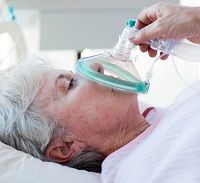Article
Comparing Humidified Nasal High-Flow Oxygen to Long-Term Oxygen Therapy in Patients with COPD
Author(s):
Study results suggest a potential reason for the better outcomes experienced by patients with COPD treated with nasal high flow oxygen therapy compared to long-term oxygen therapy.

A recent study produced adequate results to warrant additional trials of nasal high flow (NHF) oxygen therapy devices for home use for long-term management of chronic obstructive pulmonary disease (COPD) symptoms. The study, conducted by John F. Fraser of the Critical Care Research Group at The Prince Charles Hospital and University of Queensland in Brisbane, Australia, and colleagues, was published in the journal Thorax, in March, 2016.
NHF devices deliver heated and humidified oxygen at a rate of 60 L/min, and have been used for respiratory support in acute care cases. The researchers believe they may be used in-home to improve the symptoms of COPD. The researchers conducted this randomized, crossover study in order to “assess the short-term physiological effects of NHF oxygen in patients with chronic stable COPD,” they said.
Thirty patients were recruited to participate, and were randomized to receive either low flow oxygen at a rate of 2 - L/min through a nasal cannula (LTOT) or NHF at a rate of 30 L/min. The researchers collected data on transcutaneous oxygen (TcO2) and transcutaneous carbon dioxide (TcCO2), pulse oximetry, tidal volume (Vt) and minute volume (MV), respiratory rate (RR), among other measures.
The researchers found that TcO2, TcCO2, and RR were significantly lower for patients receiving NHF than those those receiving LTOT. However, dyspnea scores were higher for NHF recipients, and patients were less comfortable while receiving NHF than LTOT. The researchers suggest, “In this NHF-naive cohort, higher dyspnea and lower comfort scores were observed during NHF, perhaps due to commencing a new treatment in a cohort known to suffer from anxiety.”
The results of this study suggest that NHF could make breathing easier possible for COPD patients, while also reducing TcCO2 levels along with the risk of acute deterioration. The researchers conclude, “This short-term study demonstrates adequate physiological rationale to proceed with trailing these devices in the long-term management of COPD, with the hope of reducing further physiological decay, improving quality of life and reducing hospital admissions.




